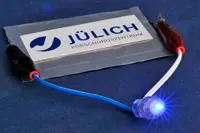 Scientists from Forschungszentrum Jülich have developed a prototype solid state lithium ion battery which is said to have an improved interface between solid electrolyte and electrodes. The cell, said to be the forerunner of a new generation of such devices, has been charged and discharged in the laboratory more than 350 times.
Scientists from Forschungszentrum Jülich have developed a prototype solid state lithium ion battery which is said to have an improved interface between solid electrolyte and electrodes. The cell, said to be the forerunner of a new generation of such devices, has been charged and discharged in the laboratory more than 350 times.
Lithium-ion batteries are currently the technology of choice, especially for mobile devices, because of their high energy density. However, the liquid electrolyte exposes them to problems such as leaking, overheating, burning and toxicity.
"The cells cannot catch fire and do not leak in accidents and errors. You can have [batteries with] a much longer life and which are less sensitive to temperature," said Professor Olivier Guillon from Jülich's Institute of Energy and Climate Research.
The electrolyte has to allow lithium ions to pass from anode to cathode during discharge and to isolate the two poles. Suitable solid materials need to have voids in their atomic lattice structure, which lithium ions can use to 'hop' through the solid.
"However," said Dr Sven Uhlenbruck, "the mechanism is slower than the diffusion processes within a liquid electrolyte. This increases the resistance to ion transport, reducing the retrievable power density of the battery. This poorer conductivity can be corrected, in principle, with a thin layer of the electrolyte. Our goal is to reduce the thickness of the solid electrolyte to a few microns."
A greater technical difficulty is said to lie in the design of the interface between the fixed electrodes and the solid electrolyte. A liquid electrolyte can work effectively with fine structured electrodes, but two adjacent solids present a different problem and the contact resistance between electrode and electrolyte is correspondingly higher. "By matching the production processes, we have managed to reduce the total internal resistance of the cell from 20k?/cm2 to 2k?/cm2," said Dr Uhlenbruck.
Author
Graham Pitcher
Source: www.newelectronics.co.uk

